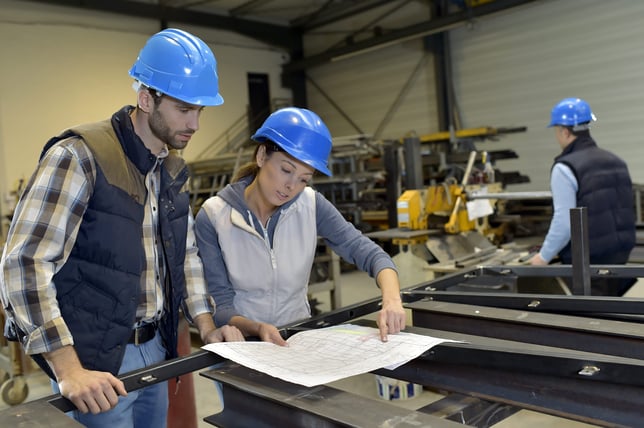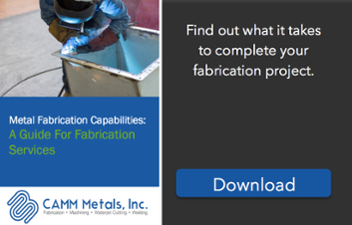The state of manufacturing is constantly changing. New developments in technology in recent years have sped up this processes of change, meaning things are moving faster than ever. In order to stay relevant and have the most efficient manufacturing systems in place, it’s important to stay up to date on the latest trends. Read below for some of the biggest trends in manufacturing this year.

1. Internet of Things (IoT)
The phrase “Internet of Things” refers to the connectivity that exists through different devices with Internet connections. IoT enables a more efficient manufacturing process through communication, programming of machines, and assessments that can lead to adjustments in procedure. Because of advancements in technology, there has been an increasing push toward using the IoT in manufacturing to create more efficient processes.
In fact, according to a recent article from Digitalistmag, about a third of all manufacturing processes and equipment incorporate smart devices or embedded intelligence. Additionally, a third of manufacturers today have strategies in place to apply IoT to their processes and to embed the technology into their product offerings. The IoT trend is improving the efficiency of production and non-production processes, as well as allowing for easy adjustments that will improve efficiency.
2. Industry 4.0
Industry 4.0, or smart manufacturing, describes the current push toward automation with advances in technology. Many experts have referred to this trend as the next Industrial Revolution because it has completely changed manufacturing. It can improve production processes as well as increase efficiency on your shop floor. You can use it to improve the safety of your shop as well. This new technology has provided manufacturers with the ability to monitor and analyze their assets in order to quickly make adjustments that will improve workflow. Smart manufacturing has even helped create simulations that help manufacturers gain insight about their systems and procedures.
Smart manufacturing is helping to improve virtually every aspect of manufacturing, from production efficiency to increased customer satisfaction. Although some manufacturers push back against these advancements in technology, those who choose to embrace these changes and invest in newer technology will see improvements in the efficiency, capabilities, and safety of their shops.
3. Automation
As technology advances, more and more processes have become automated. Robotic labor is now capable of taking over many human roles. This increase in automation has led to an increase of efficiency, less errors in manufacturing, quicker turnaround times, and lower costs. Between robotics, machine learning, and artificial intelligence, the manufacturing industry is experiencing groundbreaking changes to our fundamental processes.
Although some people worry about the replacement of human labor, automation has led to new types of jobs in manufacturing, rather than a decrease in jobs. The decision, then, comes down to what to automate and what to leave operated by people. Automation can greatly increase the speed of not only production processes, but the business end of manufacturing as well such as maintenance, management, and administration. Automated labor can lighten your workload and increase efficiency, but each manufacturer needs to decide which processes make the most sense to be automated.
4. Machine Learning
As technology advances and machines become more advanced, the capabilities of machine learning increase. New algorithms help predict customer behavior in order to make appropriate adjustments to your manufacturing processes. Machine learning leads to less room for error and better optimized workflow. New algorithms now have the ability to automate more tasks. They can teach machines how to make complex decisions in custom manufacturing. They can identify defects for quality control and create predictive and adaptive equipment maintenance procedures.
The types of algorithms associated with machine learning are different than traditional deliberate programming, which simply tells a machine what to do. Machine learning algorithms allow machines to perceive data, understand patterns, and learn. They can self-correct errors and improve their processes as they go. These improvements will greatly improve automation and allow manufacturers to get more out of their machines.
5. Green Manufacturing
In this day and age, everyone is pushing toward going green. Many manufacturers are doing their best to implement as many energy-saving green practices as possible. Investments in renewable energy to power their shops and more energy-efficient machines are becoming more common in an attempt to reduce the carbon footprint of the manufacturing energy.
Regardless of your practices, though, there continues to be a push toward green energy. Therefore, manufacturers are seeing an increase in creating products related to the industry. Manufacturers are producing the parts of solar panels, tidal turbines, wind turbines, and geothermal energy tools. Without the manufacturing industry, the Green Energy Industry could not exist. While this industry continues to grow, manufacturers continue to profit from its growth.
6. 3D Printing
3D printers are changing the way that much of manufacturing is done. Rather than typical subtractive manufacturing, 3D printers involve an additive process, laying down successive layers of material rather than cutting and shaping. In addition to the complete change in process, 3D printers have led to less design restrictions, quickly created prototypes, and the potential to deliver a printed part in less than 24 hours. 3D printers are increasing in popularity and have drastically changed the capabilities of manufacturing facilities.
In addition to the new types of processes available because of 3D printing, it also helps to reduce waste. Traditional manufacturing requires maintaining a large inventory of spare parts in order to be ready when an order is placed. With 3D printing, you will not need to invest in a large inventory, greatly reducing costs, both of the materials and of the necessary warehouse space. In addition to reducing the costs of the materials, you will not waste the materials that would typically be thrown out with traditional manufacturing, further cutting costs.
CAMM Metals | CT Metal Fabrication Company
It's crucial to do your research when choosing a metal fabrication, as not all companies are capable of completing the same quality of work. CAMM Metals has years of experience, honing our skills across the board to deliver a quality product and measurable bottom line value to our customers.



